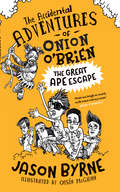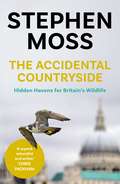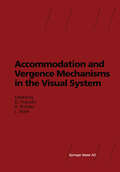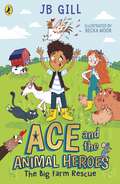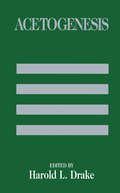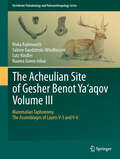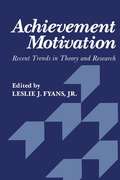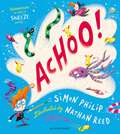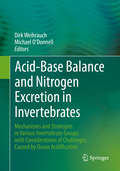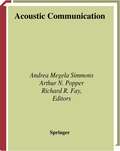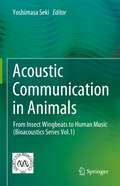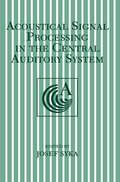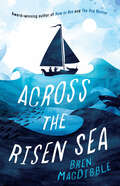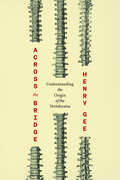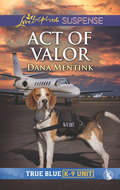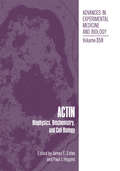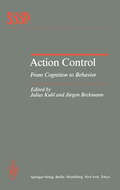- Table View
- List View
The Accidental Adventures of Onion O' Brien: The Great Ape Escape
by Jason ByrneThe Accidental Adventures of Onion O’Brien is the deadly debut from Ireland’s Got Talent’s Jason Byrne!Meet Onion O’Brien. He’s an ordinary kid growing up in the suburbs where nothing ever happens. Except when it does, it always happens to him.Luckily, his friends have his back.There’s Sive O’Connor, Dallan Okoye, Cliona O’Hare and Onion’s big brother, Derek (who thinks he’s too cool to be in the gang). Together they’re the Five O’s.The circus has come to Ballinlud and Onion’s grandad got free tickets for the whole gang! But the evening turns out to be more eventful than planned when a baby ape escapes and ends up in Onion’s back garden.Can the Five O’s save the ape from the evil ringmaster and keep her hidden in suburbia long enough to get her safely to Tota Freedom Wildlife Park?
The Accidental Countryside: Hidden Havens for Britain's Wildlife
by Stephen MossIn The Accidental Countryside, author and naturalist Stephen Moss makes a journey of discovery through Britain, in search of the hidden corners where wildlife survives against the odds. From Shetland's Iron Age stone structures to London's most modern skyscrapers, and from lowly railway cuttings to ornate stately gardens, Moss reveals the unlikely oases where wildlife thrives in areas originally created for human purposes. The result is a surprising and uplifting story of how we have influenced the landscape and wildlife of these crowded islands; and how wildlife has taken advantage of us - even when we least expected it.
Accommodation and Vergence Mechanisms in the Visual System
by LawrenceStark HansRichter OveFranzénThis conference was instigated by a combination of factors: The nature of the problem, the wide spread occupational epidemiology reported on eye symptoms and eye fatigue in the workplace, and the organizers' awareness of the complexity of the scientific and clinical bases of knowledge that might be usefully applied. The introduction of new methods into system neurobiology provides new insights into how we receive and process information from the external world, and act upon it. New, non-invasive methods have opened the way to direct observation of the human brain in action. Due particularly to the interaction between the visual and oculomotor requirements involved, several clinical and scientific fields intersect when these issues are considered. To provide clear vision the accommodative and pupillary mechanisms are used. To maintain binocularity, the ver gence oculomotor system, sensitive to fatigue, must attain congruence with accommodative levels. This accommodation-vergence linkage was a focus of our symposium.
Ace and the Animal Heroes: The Big Farm Rescue
by JB GillDr Dolittle meets Dick King-Smith in this funny, charming animal adventure from pop-star, presenter and award-winning farmer JB Gill. The perfect next read for fans of Michael Morpurgo's Mudpuddle Farm and David Baddiel's Animalcolm! 'Ace couldn't believe his ears. NO WAY did a pig, two goats and a donkey just speak!'When Ace receives a surprise gift from a long-lost relative, he and his amazing grandparents pack up their life in the city and move to the countryside to live on a run-down farm.And there's an even bigger surprise in-store for Ace when he tries on some magical new wellies and realises he can talk to animals! He's going to have to master this new skill to take on the evil Councillor Crabbington, who is determined to shut down the farm!With a little help from Ginger the Pig, some squawkative hens and a new best friend, Ace must find a way to save the farm before Councillor Crabbington gets his hands on it!Full of hilarious illustrations from Becka Moor, the illustrator behind Pamela Butchart's Wigglesbottom Primary series!
Acetogenesis (Chapman & Hall Microbiology Series)
by Harold L. DrakeThis is the first volume to provide comprehensive coverage of acetogenesis. Leading experts present state-of-the-art research, investigating the structure and function relationship of key acetogenic processes, including synthesis of ATP, the conservation of energy, and intersecting metabolic pathways. It explores the interactions between acetogenic bacteria and the flow of matter and energy, giving the reader an integrated perspective on acetogens and the environment. It presents landmark advances in the biochemistry, phylogeny, and molecular biology of acetogens, with lucid explanations of background material, making this volume accessible to newcomers to the subject. It discusses diverse functions of acetogenesis in soils, and gastrointestinal tracts, as well as current and potential commercial and environmental applications. This volume will serve as a broad and in-depth review of basic and emerging issues in acetogenesis for microbiologists, molecular biologists, biochemists, and ecologists, and as a stimulus for future research.
The Acheulian Site of Gesher Benot Ya‘aqov Volume III: Mammalian Taphonomy. The Assemblages of Layers V-5 and V-6 (Vertebrate Paleobiology and Paleoanthropology)
by Rivka Rabinovich Sabine Gaudzinski-Windheuser Lutz Kindler Naama Goren-InbarMultidisciplinary research on the Early-Middle Pleistocene site of Gesher Benot Ya‘aqov has yielded abundant climatic, environmental, ecological and behavioral records. The 15 archaeological horizons form a sequence of Acheulian occupational episodes on the shore of the paleo-Lake Hula. These enable us to reconstruct numerous aspects of the survival and adaptation of ancient hominins, leading to a better understanding of their evolution and behavior. This book presents the faunal analyses of medium-sized and large mammals, providing taxonomic, taphonomic and actualistic data for the largest faunal assemblages. The study of modes of animal exploitation reveals valuable information on hominin behavior.
Achievement Motivation: Recent Trends in Theory and Research
by FyansThis book started as a symposium on Achievement Motiva tion at the 1978 American Educational Research Association Convention. The participants in that symposium were Jack Atkinson, Martin Maehr, Dick De Charms, Joel Raynor, and Dave Hunt. The subsequent response to that symposium indicated a "coming of age" for motivation theory in terms of education. Soon afterward, at a Motivation in Education Conference at University of Michigan, Ann Arbor, it became apparent that due to this emergence of motivation what was needed was a comprehensive perspective as to the state of the art of achievement theory. Achievement theory had by now well surpassed its beginnings in the 1950s and 1960s and was ready for a composite presentation and profile of the recent research and theories of motivation. Thus, this volume was born. I would like to take this opportunity to thank each contribu tor to this book as well as Robert L. Linn who critically reviewed several of the manuscripts. Thanks are also due to my former graduate advisors, Martin L. Maehr, Maurice Tatsuoka, and Harry Triandis, for the viewpoints given me in graduate school education which I hope have benefitted this under taking. Joyce Fitch did a splendid joh typing many of these chapters and special gratitude should be given to Judy Cadle of Professional Services, Inc. for the composition and proofing of this book.
ACHOO!: A laugh-out-loud picture book about sneezing
by Simon PhilipA hilarious book about the importance of ALWAYS covering your nose when you sneeze . . . and what happens if you don't!You probably know it's good manners to ALWAYS cover your nose when you sneeze. But when Sid forgets this very simple rule, the consequences are WILDER than he could ever have predicted. Get ready for a laugh-out-loud, sneeze-driven joyride, featuring elephants, pirates, acrobats, giants, princesses and a whole lot of pandas. Sneezing will never be the same again!This joyfully anarchic, side-splittingly funny story is perfect for fans of You Can't Take an Elephant on the Bus and There's a Shark in the Bath.From the bestselling, award-winning author of YOU MUST BRING A HAT (Sainsbury's Children's Book of the Year 2016) and I REALLY WANT THE CAKE (shortlisted for the Waterstones Children's Book Prize 2018), and the illustrator of THINK BIG and INCREDIBLE YOU
Acid-Base and Electrolyte Handbook for Veterinary Technicians
by Angela Randels 8208 Thorp David LissAcid-Base and Electrolyte Handbook for Veterinary Technicians provides an easy to understand yet comprehensive approach to acid-base and electrolyte balance. Covers the physiology of fluids and their effect on acid-base and electrolyte balance Offers detailed information on managing acid-base and electrolyte derangements in disease Includes access to a companion website with case studies and multiple choice questions
Acid-Base and Electrolyte Handbook for Veterinary Technicians
by Angela Randels-Thorp David LissAcid-Base and Electrolyte Handbook for Veterinary Technicians provides an easy to understand yet comprehensive approach to acid-base and electrolyte balance. Covers the physiology of fluids and their effect on acid-base and electrolyte balance Offers detailed information on managing acid-base and electrolyte derangements in disease Includes access to a companion website with case studies and multiple choice questions
Acid-Base Balance and Nitrogen Excretion in Invertebrates: Mechanisms and Strategies in Various Invertebrate Groups with Considerations of Challenges Caused by Ocean Acidification
by Dirk Weihrauch Michael O’DonnellThis textbook provides a comprehensive overview on the diverse strategies invertebrate animals have developed for nitrogen excretion and maintenance of acid-base balance and summarizes the most recent findings in the field, obtained by state-of-the-art methodology. A broad range of terrestrial, freshwater and marine invertebrate groups are covered, including crustaceans, cephalopods, insects and worms. In addition the impact of current and future changes in ocean acidification on marine invertebrates due to anthropogenic CO2 release will be analyzed. The book addresses graduate students and young researchers interested in general animal physiology, comparative physiology and marine/aquatic animal physiology. Also it is an essential source for researchers dealing with the effects of increasing pCO2 levels on aquatic animals, of which the vast majority are indeed invertebrates. All chapters are peer-reviewed.
Acid Proteases: Structure, Function, and Biology (Advances in Experimental Medicine and Biology #95)
by Jordan TangIn the past ten years, a number of proceedings of symposia on the structure and function of proteolytic enzymes have been pub lished. Their coverage of acid proteases has been limited, mainly due to the lack of significant new information on the structure of these enzymes. In the last four years, however, the primary and tertiary structures of a number of acid proteases have been deter mined, prompting the need to discuss the meanings of the old data and the possibilities for new experimentations. It was for this purpose that the "Conference on Acid Proteases: Structure, Function, and Biology" was organized. It took place at the University of Oklahoma on November 21-24, 1976. This book is a collection of the main lectures delivered at the Conference. Acid Proteases, by definition refers to a group of proteases having an optimal pH in acidic solutions. The classic examples are pepsin and chymosin. Some catalytic features are obviously shared by these proteases, most notably, their inhibition by pepstatin. The use of active center-directed inactivators such as diazoacetyl norleucine methyl ester and 1,2-epoxy-3-(p-nitrophenoxy)propane has shown that two catalytic aspartyl residues are present in most of these enzymes. These apparent cornmon features have prompted the suggestion by several investigators to name this group of enzymes "aspartyl proteases" or "carboxyl proteases".
Acoustic Communication (Springer Handbook of Auditory Research #16)
by Richard R. Fay Andrea SimmonsIn order to communicate, animals send and receive signals that are subject to their particular anatomical, psychological, and environmental constraints. This SHAR volume discusses both the production and perception of acoustic signals. Chapters address the information that animals communicate, how the communication is developed and learned, and how communication systems have adapted and evolved within species. The book will give examples from a variety of species.
Acoustic Communication in Animals: From Insect Wingbeats to Human Music (Bioacoustics Series Vol.1)
by Yoshimasa SekiThis book is the first volume of the bioacoustics series published by the Society for Bioacoustics. This volume provides an overview of the advances and recent topics in acoustic communication in various animals. Most animals produce vibrations and sounds by moving their body parts, including vocal organs. These sounds can be research targets of bioacoustics studies. How animals use these sounds, especially in inter-individual relationships, is the focus of this volume, “Acoustic Communication in Animals”. The authors’ expertise varies from molecular biology, neurobiology to psychology, and human brain imaging. Their research subjects range from invertebrates to humans. Despite the variety of topics, chapters are developed under the consideration of ethology and evolution. Readers will recognize the profundity of the topics in each chapter. In addition, the view and understanding of natural sound sequences produced by animals can vary among different cultures. Research from Japan and regions that have been underrepresented in previous literature can offer new ideas and unique perspectives in the study of bioacoustics. Readers can grasp the progress of this research field in a broad range of species in one book. The book presents multi- and interdisciplinary topics and appeals to researchers and students in fields including psychology, physiology, zoology, ethology, and neurosciences.
Acoustical Signal Processing in the Central Auditory System
by Josef SykaThe symposium on Acoustical Signal Processing in the Central Auditory System which was held in Prague on September 4--7, 1996 was the third in a series organized in Prague, after the Neuronal Mechanisms of Hearing symposium in 1980 and Auditory Pathway - Structure and Function symposium in 1987. Approximately 100 scientists regis tered for the symposium and presented 82 separate papers and posters. The present vol ume contains 53 of these contributions, mostly presented at the symposium as invited review papers. Several essential changes occurred since the previous meeting in 1987. In auditory neuroscience, recently developed methods opened new horizons in the investigation of the structure and function of the central auditory pathway. Methods like c-fos tracing tech niques and monoclonal antibodies for neurotransmitters and their receptors, like the intro duction of electrophysiological recording from brain slices have made possible new insights into the function of individual neurons and their interconnections, particularly in the cochlear nuclei and in the superior olivary complex. Integrative approaches towards understanding the central auditory function started to dominate in the field. It is not easy at the present time to differentiate between purely morphological and neurochemical ap proaches; similarly electrophysiological approaches are accompanied inevitably by behav ioral and psychophysical studies. The understanding of human brain function advanced significantly during the last several years. mainly due to the contribution of magneto encephalography. positron emission tomography and functional nuclear magnetic reso nance imaging.
Across The Risen Sea (PDF)
by Bren MacDibbleIn a climate changed world, this adventure with sinkholes, crocodiles, sharks, pirates, floating cities, vertical farms and a mystery to solve poses the question of how we will all live 'afterwards'. Will kindness and a sense of community win over selfish greed to preserve our planet - and humanity? From multi-awarding winning Australian 'eco-fiction' author of 'How to Bee' and 'The Dog Runner' Bren MacDibble.
Across the Bridge: Understanding the Origin of the Vertebrates
by Henry GeeOur understanding of vertebrate origins and the backbone of human history evolves with each new fossil find and DNA map. Many species have now had their genomes sequenced, and molecular techniques allow genetic inspection of even non-model organisms. But as longtime Nature editor Henry Gee argues in Across the Bridge, despite these giant strides and our deepening understanding of how vertebrates fit into the tree of life, the morphological chasm between vertebrates and invertebrates remains vast and enigmatic. As Gee shows, even as scientific advances have falsified a variety of theories linking these groups, the extant relatives of vertebrates are too few for effective genetic analysis. Moreover, the more we learn about the species that do remain—from sea-squirts to starfish—the clearer it becomes that they are too far evolved along their own courses to be of much use in reconstructing what the latest invertebrate ancestors of vertebrates looked like. Fossils present yet further problems of interpretation. Tracing both the fast-changing science that has helped illuminate the intricacies of vertebrate evolution as well as the limits of that science, Across the Bridge helps us to see how far the field has come in crossing the invertebrate-to-vertebrate divide—and how far we still have to go.
Across the Bridge: Understanding the Origin of the Vertebrates
by Henry GeeOur understanding of vertebrate origins and the backbone of human history evolves with each new fossil find and DNA map. Many species have now had their genomes sequenced, and molecular techniques allow genetic inspection of even non-model organisms. But as longtime Nature editor Henry Gee argues in Across the Bridge, despite these giant strides and our deepening understanding of how vertebrates fit into the tree of life, the morphological chasm between vertebrates and invertebrates remains vast and enigmatic. As Gee shows, even as scientific advances have falsified a variety of theories linking these groups, the extant relatives of vertebrates are too few for effective genetic analysis. Moreover, the more we learn about the species that do remain—from sea-squirts to starfish—the clearer it becomes that they are too far evolved along their own courses to be of much use in reconstructing what the latest invertebrate ancestors of vertebrates looked like. Fossils present yet further problems of interpretation. Tracing both the fast-changing science that has helped illuminate the intricacies of vertebrate evolution as well as the limits of that science, Across the Bridge helps us to see how far the field has come in crossing the invertebrate-to-vertebrate divide—and how far we still have to go.
Across the Bridge: Understanding the Origin of the Vertebrates
by Henry GeeOur understanding of vertebrate origins and the backbone of human history evolves with each new fossil find and DNA map. Many species have now had their genomes sequenced, and molecular techniques allow genetic inspection of even non-model organisms. But as longtime Nature editor Henry Gee argues in Across the Bridge, despite these giant strides and our deepening understanding of how vertebrates fit into the tree of life, the morphological chasm between vertebrates and invertebrates remains vast and enigmatic. As Gee shows, even as scientific advances have falsified a variety of theories linking these groups, the extant relatives of vertebrates are too few for effective genetic analysis. Moreover, the more we learn about the species that do remain—from sea-squirts to starfish—the clearer it becomes that they are too far evolved along their own courses to be of much use in reconstructing what the latest invertebrate ancestors of vertebrates looked like. Fossils present yet further problems of interpretation. Tracing both the fast-changing science that has helped illuminate the intricacies of vertebrate evolution as well as the limits of that science, Across the Bridge helps us to see how far the field has come in crossing the invertebrate-to-vertebrate divide—and how far we still have to go.
Across the Bridge: Understanding the Origin of the Vertebrates
by Henry GeeOur understanding of vertebrate origins and the backbone of human history evolves with each new fossil find and DNA map. Many species have now had their genomes sequenced, and molecular techniques allow genetic inspection of even non-model organisms. But as longtime Nature editor Henry Gee argues in Across the Bridge, despite these giant strides and our deepening understanding of how vertebrates fit into the tree of life, the morphological chasm between vertebrates and invertebrates remains vast and enigmatic. As Gee shows, even as scientific advances have falsified a variety of theories linking these groups, the extant relatives of vertebrates are too few for effective genetic analysis. Moreover, the more we learn about the species that do remain—from sea-squirts to starfish—the clearer it becomes that they are too far evolved along their own courses to be of much use in reconstructing what the latest invertebrate ancestors of vertebrates looked like. Fossils present yet further problems of interpretation. Tracing both the fast-changing science that has helped illuminate the intricacies of vertebrate evolution as well as the limits of that science, Across the Bridge helps us to see how far the field has come in crossing the invertebrate-to-vertebrate divide—and how far we still have to go.
Across the Bridge: Understanding the Origin of the Vertebrates
by Henry GeeOur understanding of vertebrate origins and the backbone of human history evolves with each new fossil find and DNA map. Many species have now had their genomes sequenced, and molecular techniques allow genetic inspection of even non-model organisms. But as longtime Nature editor Henry Gee argues in Across the Bridge, despite these giant strides and our deepening understanding of how vertebrates fit into the tree of life, the morphological chasm between vertebrates and invertebrates remains vast and enigmatic. As Gee shows, even as scientific advances have falsified a variety of theories linking these groups, the extant relatives of vertebrates are too few for effective genetic analysis. Moreover, the more we learn about the species that do remain—from sea-squirts to starfish—the clearer it becomes that they are too far evolved along their own courses to be of much use in reconstructing what the latest invertebrate ancestors of vertebrates looked like. Fossils present yet further problems of interpretation. Tracing both the fast-changing science that has helped illuminate the intricacies of vertebrate evolution as well as the limits of that science, Across the Bridge helps us to see how far the field has come in crossing the invertebrate-to-vertebrate divide—and how far we still have to go.
Across the Bridge: Understanding the Origin of the Vertebrates
by Henry GeeOur understanding of vertebrate origins and the backbone of human history evolves with each new fossil find and DNA map. Many species have now had their genomes sequenced, and molecular techniques allow genetic inspection of even non-model organisms. But as longtime Nature editor Henry Gee argues in Across the Bridge, despite these giant strides and our deepening understanding of how vertebrates fit into the tree of life, the morphological chasm between vertebrates and invertebrates remains vast and enigmatic. As Gee shows, even as scientific advances have falsified a variety of theories linking these groups, the extant relatives of vertebrates are too few for effective genetic analysis. Moreover, the more we learn about the species that do remain—from sea-squirts to starfish—the clearer it becomes that they are too far evolved along their own courses to be of much use in reconstructing what the latest invertebrate ancestors of vertebrates looked like. Fossils present yet further problems of interpretation. Tracing both the fast-changing science that has helped illuminate the intricacies of vertebrate evolution as well as the limits of that science, Across the Bridge helps us to see how far the field has come in crossing the invertebrate-to-vertebrate divide—and how far we still have to go.
Act Of Valor: Act Of Valor Running Target Killer Exposure (True Blue K-9 Unit #4)
by Dana MentinkShe saw something she shouldn't have…
Actin: Biophysics, Biochemistry, and Cell Biology (Advances in Experimental Medicine and Biology #358)
by James E. Estes Paul J. HigginsDuring the period August 5-9, 1992, and immediately preceding the 1992 Gordon Research Conference on Motile and Contractile Systems, the "Third International Conference on the Structure and Function of Ubiquitous Cellular Protein Actin" was held at the Emma Willard School in Troy, New York, under the title "ACTIN '92". This conference focused on the fundamental properties and cellular functions of actin and actin based microfilament systems. The first conference in this series was held in 1982, in Sydney, Australia, and hosted by Dr. Cristobal G. dos Remedios and Dr. Julian A. Barden, both from the University of Sydney (New South Wales, Austrailia). The second conference convened in Monza, Italy in June 1987, and was organized by Dr. Roberto Colombo, University of Milan (Italy). This third gathering of researchers devoted to the study of actin and actin-associated proteins was organized by Dr. James E. Estes, Albany Stratton V A Medical Center and Dr. Paul 1. Higgins, Albany Medical College, who were assisted by an Organizing Committee consisting of Dr. Edward D. Korn (National Heart, Lung and Blood Institute, NIH), Dr. Thomas P. Stossel (Massachusetts General Hospital), Dr. Fumio Matsumura (Rutgers University), and Dr. Stephen Farmer (Boston University). This meeting was dedicated to the many pioneering contributions of Professor Fumio Oosawa to the field of actin research.
Action Control: From Cognition to Behavior (Springer Series in Social Psychology)
by JürgenBeckmann JuliusKuhl"It is not thought as such that can move anything, but thought which is for the sake of something and is practical." This discerning insight, which dates back more than 2000years to Aristotle, seems to have been ignored by most psycholo gists. For more than 40years theories of human action have assumed that cogni tion and action are merely two sides of the same coin. Approaches as different as S-O-R behaviorism,social learning theory, consistency theories,and expectancy value theories of motivation and decision making have one thing in common: they all assume that "thought (or any other type of cognition) can move any thing," that there is a direct path from cognition to behavior. In recent years, we have become more and more aware of the complexities in volved in the relationship between cognition and behavior. People do not always do what they intend to do. Aside from several nonpsychological factors capable of reducing cognition-behavior consistency, there seems to be a set of complex psychological mechanisms which intervene between action-related cognitions, such as beliefs, expectancies, values, and intentions,and the enactment of the be havior suggested by those cognitions. In our recent research we have focused on volitional mechanismus which presumably enhance cognition-behavior consistency by supporting the main tenance of activated intentions and prevent them from being pushed aside by competing action tendencies.
